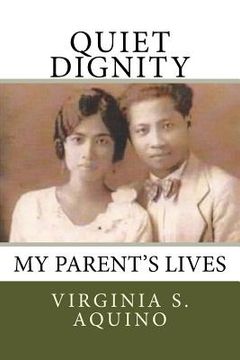Reseña del libro "Quiet Dignity (en Inglés)"
INTRODUCTION This Is the life story of my parents who were born of the most humble circumstances in towns in Pangasinan, one of the provinces in northern Luzon of the Philippine Islands in the early twentieth century. At that time, not too long after the Spanish-American War of 1898 in Manila Bay, the victorious Americans claimed for themselves the island long under the rule of the Spaniards. Essentially, the Spanish occupation of the Philippines began when Ferdinand Magellan, a Portuguese sailor, sailing under the flag of King Philip II of Spain discovered the Island. For four hundred years or generations, the inhabitants got indoctrinated with the Catholic faith, and got soaked in the Spanish culture or influence. After the defeat of the Spanish armada in Manila Bay, Spain seceded the Philippines to America for peanuts - $20 million, taking us one of its commonwealths. The Filipinos rejected the prospect of another colonizer, so there began the Philippine Insurrection, the first foreign war of the United States. The bolos and knives of the courageous Filipino fighters were way too inept in their encounters with the U.S. military. But the Filipino bravery resulted in a significant number of American casualties. Victorious, the new "conquistadores" were in stark contrast with the Spaniards, in that they were more kindly and more humane. America sent the first batch of teachers, dubbed "The Thomasites" after the name of the ship that transported them. They arrived in the year 1900. They taught the natives English among others, and as a result of their missionary zeal to educate they produced exemplary graduates. In time, high school graduates, and even elementary (6th graders) graduates were so capable and knowledgeable that they were allowed to teach. Most of the people in the provinces had landholdings which was their form of security in life, the source of their subsistence. Most often they owned the land and they tilled it themselves. There was no other form of investments like what the modern world has now. Stock markets, big corporations or big businesses was unheard of, at least in the provinces. The people were not nomadic themselves, except on rare occasions when a family member or two would leave for another province, or for Mindanao, the southern part of the island. Most often people intermarry within their village, town or community. During this period, the Philippines was mostly rural. No electricity but gas lamps or lamps with wicks dipping in coconut oil or kerosene. Cooking was by firewood in a wooden or clay stove and water was pumped from an artesian well. Deep wells abounded in many areas, and a bucket tied to a rope was used to fetch water from the well. Of bamboo and thatches houses were made. Roadways were dirt or gravel. The conveniences of living were few and only the moneyed class had them. At the time of the Commonwealth, they were still a novelty to most. It was in this setting when my father, Marcelino Ellana Aquino was born in a village called Cabaruan in the town of San Fabian (named after Pope St. Fabian) in Pangasinan, and my mother, Teofila Mararac Solomon, eleven years later, in Poblacion or town proper in San Jacinto, also in Pangasinan. The two towns - San Fabian and San Jacinto - are adjacent with each other, with a river called "Patalan" and a quarry separating each other. + + + Contents Introduction, 4 Father's Family, 7 Mother's Family, 19 The Wedding, 34 The Prewar Years and the Japanese Occupaction, 44 The Postwar Years, 51 Retirement, 83 Immigration to USA, 87 Epilogue, 106 Pictures, 108

